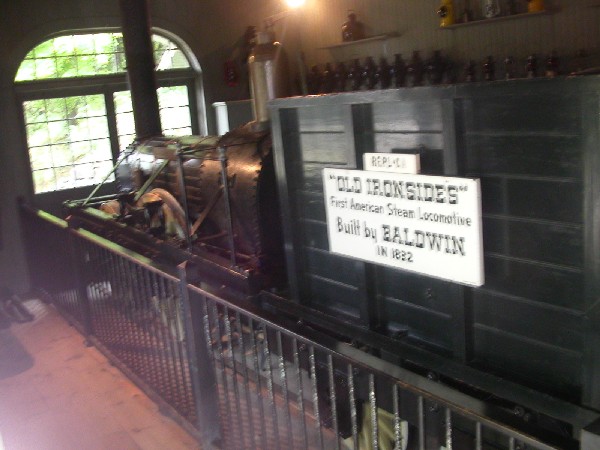Wow! Two days in one museum! We were told that the Shelburne Museum was one of those “don’t miss it” places. It is open from 10 to 5 daily until the end of October. We opened it and closed it on Saturday. We didn’t even stop for lunch. We took along some munchies and just kept going and going like the Eveready bunny. The museum grounds are huge and have dozens of building that have been moved here from all over New England by an eclectic New York collector, Electra Havemeyer Webb. To start with there is an impressive collection of art, including important European artists like Monet, but also American artists and folk art too. The largest artifact is the side-wheeler “Ticonderoga” that plied the waters of Lake Champlain for the first half of the twentieth century, (1906 – 1953). Its last voyage was across two miles of Vermont farmlands in the dead of winter to take advantage of the solidly frozen ground. This ship is 220 feet long and 70 or 80 feet wide.
They have a railroad depot, and it has the most accurate portrayal of a telegrapher’s work area I have seen in any of the railroad museum yet. It has a caps only typewriter that is used just for typing train orders, and all of the telegraph equipment is in order. It even includes whirligig stands with rubber stamps for anything you might need to stamp on waybills and passenger tickets. It was just like stepping back into my railroading days in the early 60’s. Of course they have an important piece of railroad iron. Neil will like this one. It is Baldwin’s first ever locomotive, number 1. In the designation lingo for engines I guess this one would be called a 2-2-0. The leading truck has two wheels and they are slightly smaller than the drivers. The drivers are behind them and the axle has cranks and the pistons are inside the wheels. I will include a photo below.
We have talked about ships and trains. How about horse drawn wagons? Yes they have over two hundred of these. Everything from simple pony carts and buckboards to elaborate luxury coaches used by the wealthy of New York City.
Are you a circus fan or a carousel lover? They have all of the carved animals from a 40 place carousel carved by the famed Daniel Muller in about 1902. They have a miniature circus parade carved at an inch to the foot scale. The parade stretches out for over 500 feet and is made up of over 4,000 figures. It was hand carved from Ponderosa Pine by Roy Arnold and four assistants. Judy and I were studying some of the wagons and horse teams. We were expecting cast figurines and kept looking for exact duplicates. There were none! Every horse had a different pose. A different toss of his head, a different lead of the hooves, and all so realistic you expected them to prance. Many of the wagons were four or six horse hitches. Two larger band wagons had forty horses for one and forty camels for the other. The menagerie cage wagons included about every animal you have ever seen in all of the zoos around the country.
This is getting too long and I haven’t scratched the surface yet, so I will curb my enthusiasm, but if you ever get a chance to come to Vermont, this museum is on par with the Smithsonian in D.C. And don’t short yourself. Plan to spend two full days on the grounds. We saw busses come in and drop off their loads of people for a couple hours. They would have to have running shoes just to visit all of the houses, much less see any of the exhibits. Take a peak at their web site at . (Shelburne Museum)
Judy and I send our love to all of our friends back home. Good bye for now.
Gary and Judy
P.S. We are back in our Verizon internet territory, so I can respond to e-mails if you want to comment about our blog, or update us on things happening in your lives. It was a real challenge in Canada finding libraries to get our e-mail and answer them. We found places that wanted as much as a dollar a minute to get on the internet. Of course the Canadian dollar is less and their minutes are more easy going. Eh!
Gary
